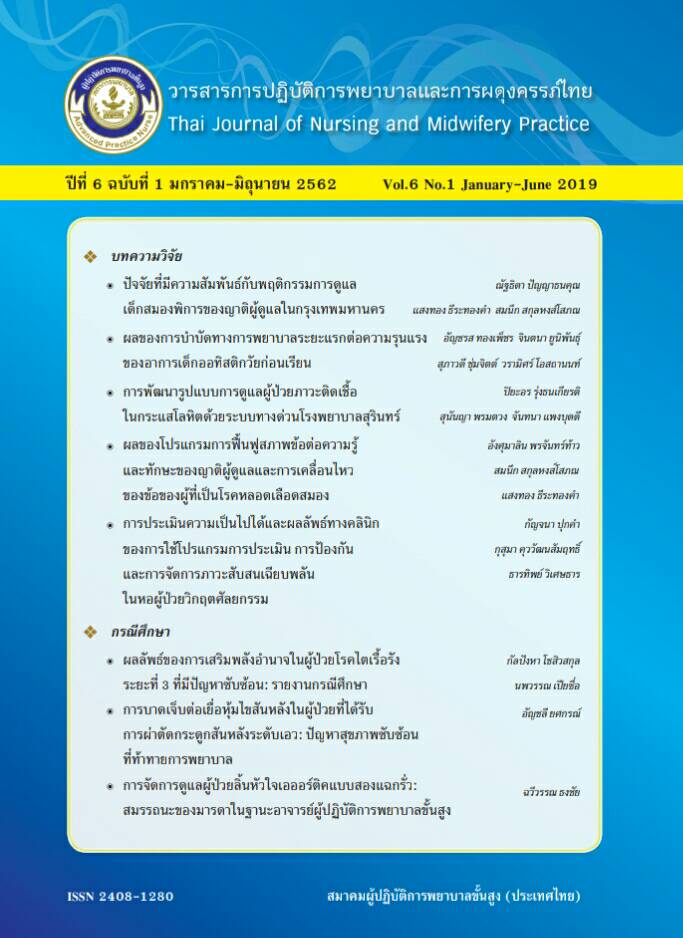การประเมินความเป็นไปได้และผลลัพธ์ทางคลินิกของการใช้โปรแกรมการประเมิน การป้องกันและการจัดการภาวะสับสนเฉียบพลันในหอผู้ป่วยวิกฤตศัลยกรรม
Main Article Content
บทคัดย่อ
บทคัดย่อ: การวิจัยปฏิบัติการนี้ เพื่อศึกษาความเป็นไปได้ทางห้องปฏิบัติและผลลัพธ์การใช้โปรแกรมการประเมิน การป้องกัน และการจัดการภาวะสับสนเฉียบพลัน ในหอผู้ป่วยวิกฤตศัลยกรรมของโรงพยาบาลมหาราชนครศรีธรรมราช กลุ่มตัวอย่างมี 2 กลุ่ม คือ พยาบาลที่ดูแลผู้ป่วยวิกฤต จำนวน 21 คน และผู้ป่วยวิกฤตศัลยกรรม จำนวน 62 คน ช่วงเวลาศึกษาเดือนกุมภาพันธ์ ถึง กันยายน พ.ศ. 2561 เครื่องมือวิจัย คือ แบบบันทึกข้อมูลส่วนบุคคลและข้อมูลการเจ็บป่วย แบบประเมินความเป็นไปได้ทางการปฏิบัติ แบบประเมินความรู้เกี่ยวกับภาวะสับสนเฉียบพลัน แบบประเมินกระบวนการปฏิบัติของพยาบาล แบบประเมินความปวด ภาวะกายใจไม่สงบ และภาวะสับสนเฉียบพลัน และคู่มือการปฏิบัติตามโปรแกรม ABCDEF ผลการวิจัยพบว่า ผลลัพธ์ด้านกระบวนการใช้โปรแกรม ได้แก่ ความรู้ของพยาบาลหลังสอนและหลังใช้โปรแกรม 1 เดือนมากกว่าก่อนสอนอย่างมีนัยสำคัญทางสถิติที่ระดับ .05 รวมทั้งมากกว่าค่าเป้าหมาย (>70%) และพยาบาลมีความคิดเห็นว่ามีความเป็นไปได้ในทางปฏิบัติอยู่ในระดับมาก ร้อยละ 90.47 สว่นกระบวนการที่ผู้ป่วยได้รับจากการปฏิบัติตามโปรแกรม ABCDEF ครบถ้วน 3 กิจกรรม พบการปฏิบัติร้อยละ 79.03-100.0 ผลลัพธ์หลังใช้โปรแกรม พบว่าส่วนใหญ่มีความปวดเฉลี่ยอยู่ในระดับเล็กน้อย ด้านภาวะกายใจไม่สงบ พบว่า ผ่านค่าเป้าหมายเพิ่มขึ้นจากวันที่ 1-7 ร้อยละ 65.05-75.36 และพบว่าผู้ป่วยเกิดภาวะสับสนเฉียบพลัน ร้อยละ 41.93 โดยมีลักษณะอาการแบบวุ่นวาย (hyperactive) มากที่สุดร้อยละ 22.58 รองลงมาแบบผสมผสาน (mixed subtype) ร้อยละ 16.13 ซึ่งพบแบบซึม (hypoactive) น้อยที่สุด ร้อยละ 3.22 และส่วนใหญ่ เกิดภาวะสับสนเฉียบพลันในช่วง 1-3 วัน ร้อยละ 61.54 โปรแกรมนี้มีความเป็นไปได้ในการใช้ดูแลผู้ป่วยภาวะวิกฤต โดยสามารถช่วยเพิ่มความรู้ในดารดูแลของพยาบาลและก่อให้เกิดผลลัพธ์ที่ดีต่อผู้ป่วย
Downloads
Article Details
References
2. Oh ES, Fong TG, Hshieh TT, Inouye SK. Delirium in older persons advanced in diagnosis and treatment. American Medical Association 2017;318 (12):1161-74.
3. Van den BM, Schoonhoven L, Van der Hoeven JG, Van AT, Pickkers P. Incidence and short term consequences of delirium in critically ill patients: A prospective observational cohort study. International Journal of nursing study 2011;49(2012):775-83.
4. Ouimet S, Kavanagh BP, Gottfried SB, Skrobik Y. Incidence, risk factors and consequences of ICU delirium. Intensive Care Medicine 2007;33:66–73.
5. Joseph BH, Nikhil P. Delirium in the Neuro Intensive Care Unit. Critical Care Nurse 2016;28:21-35.
6. Information center. Surgical critical care statistics of Maharaj Nakhon Si Thammarat Hospital. Nakhon Si Thammarat: Maharaj Nakhon Si Thammarat Hospital;2016.(In Thai)
7. Barr J,Gilles LF, Kathleen PE, Wesley E, Celine G, Joseph FD. et al. Clinical practice guidelines for the management of pain agitation and delirium in adult patients in the intensive care unit: Executive summary Am J Health-Syst Pharm 2013;70:53-8.
8. Heymann A, Radtke F, Schiemann A. Delayed treatment of delirium increases mortality rate in intensive care unit patients. Journal of Intensive Medicine Respiratory 2010;38:1584–95.
9. Pisani MA, Kong SY, Kasl SV, Murphy TE, Araujo KL, VanNess PH. Days of delirium are associated with 1-year mortality in an older intensive care unit population. Journal of Respiratory Critical Care Medicine 2009; 180:1092–97.
10. Uppanisakorn S, Seangnhern U, Intaraksa P, Chinnawong T. Factor related to the knowledge about delirium in critical ill patients among nurse.Thai journal of critical care medicine 2010;17;2:6-12.(In Thai)
11. Glynn L, Corry M. Intensive care nurses’ opinions and current practice in relation to delirium in the intensive care setting. Intensive and Critical Care Nursing 2015;31:269-75.
12. Sarah BB, Maeve CL, Peter PY, Jame JS, Anne CM. Delirium prevention program in the surgical intensive care unit improved the outcomes of older adults. Journal of surgical research 2014;190:280-8.
13. Trogric Z, Jagt MV, Bakker J, Balass MC, Ely EW, Voort PH, Ista E. A systematic review of implementation strategies for assessment prevention and management of ICU delirium and their effect on clinical outcomes. Journal of Critical care 2015;19(157):1-17.
14. Balas MC, et al. Adapting the ABCDEF bundle to meet the needs of patients requiring prolonged mechanical ventilation in the long-term acute care hospital setting: Historical perspectives and practical implications. Semin Respir Crit Care Med 2016;37(1):119–135.
15. Donabedian, A. An Introduction to quality assurance in health care. Oxford: Oxford University Press; 2003.
16. Tananuchittikul Y. Application of APACHE II scores in the General Intensive Care Unit, Lampang Hospital. Journal of Health Science 2014;23 (2):298-304.
17. Bansuparb R. Development of clinical practice guideline for traumatic wound management in the emergency room, Lee Hospital, Lamphun Province. Master of Nursing Science (Adult Nursing) Chiang Mai University 2551. (In Thai)
18. Floyd D, Walker P, Vanderveen T, Lewis S, Diring D, Januszewic L, et al. ICU Sedation Guideline of care. San Diego Patient Safety Council 2009:1-44.
19. Lumyong T, Jitpanya C. Factors related to delirium in ICU patients with mechanical ventilators. Thai Journal of Cardio Thoracic Nursing 2012;23 (1):19-30. (In Thai)
20. Morandi A, Myatra SN, Azoulay E, Fagoni N, Inoue S, Kotfis K, et al. Worldwide Survey of the“Assessing pain, Both spontaneous awakening and breathing trials, Choice of drugs, Delirium monitoring/ management, Early exercise/mobility and Family empowerment”(ABCDEF) Bundle. Critical Care Medicine 2017;45(11): 1111-21.
21. Hollinger A, Siegemund M, Goettel N, Steiner LA. Postoperative delirium in cardiac surgery: An Unavoidable menace? Journal of Cardiothoracic and Vascular Anesthesia 2015;29(6),1677-87. 22. Hipp DM, Ely EW. Pharmacological and nonpharmacological management of delirium in critically ill patients. Neurotherapeutics 2012;9: 158–175.
22. Hipp DM, Ely EW. Pharmacological and nonpharmacological management of delirium in critically ill patients. Neurotherapeutics 2012;9:158–175.

